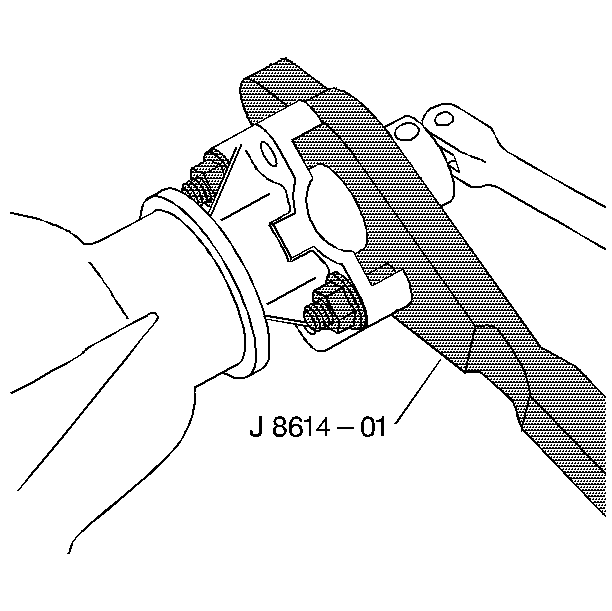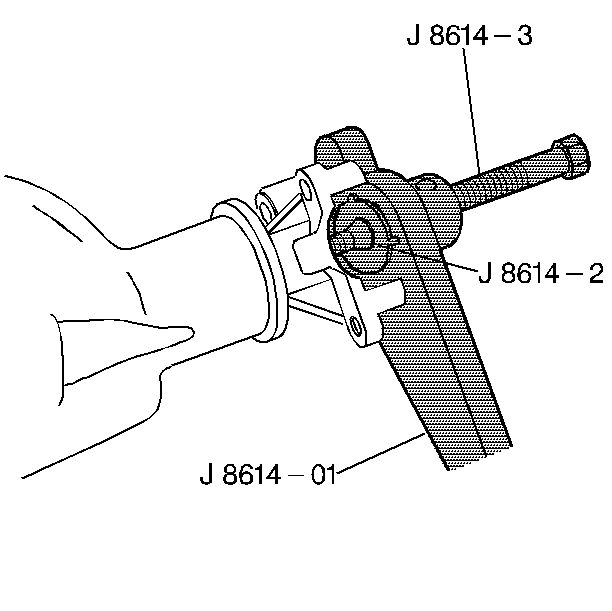Removal Procedure
Tools Required
J 8614-01 Companion Flange Holder
- Raise and support the vehicle. Refer to Lifting and Jacking the Vehicle in General Information.
- Remove the rear wheels. Refer to Tire and Wheel Removal and Installation in Tires and Wheels.
- Remove the drums, if equipped. Refer to Brake Shoe Replacement in Drum Brakes.
- Remove the rear rotors, if equipped. Refer to Rear Brake Rotor Replacement in Disc Brakes.
- Remove the propeller shaft. Refer to Rear Propeller Shaft Replacement in Propeller Shaft.
- Measure the amount of torque required to rotate the pinion. Use an inch-pound torque wrench. Record this measurement for reassembly. This will give the combined preload for the following components:
- Draw two arrows pointing at each other. One on the pinion stem. The other on the pinion yoke/flange.
- Record the number of exposed threads on the pinion stem for reference.
- Remove the pinion yoke/flange nut and washer. Hold the pinion yoke/flange using a J 8614-01 .
- Remove the pinion yoke/flange using J 8614-01 . Use a container in order to retrieve the lubricant.
Important: Observe and mark the positions of all the driveline components, relative to the propeller shaft and the axles, prior to disassembly. These components include the propeller shafts, drive axles, pinion flanges, output shafts, etc. Reassemble all the components in the exact places in which you removed the parts. Follow any specifications, torque values, and any measurements made prior to disassembly.

| • | The pinion bearings |
| • | The pinion seal |
| • | The carrier bearings |
| • | The axle bearings |
| • | The axle seals |


Installation Procedure
Tools Required
J 8614-01 Companion Flange Holder
- Apply sealant (GM P/N 12346004) to the inside sealing surface of the pinion yoke/flange.
- Apply seal lubricant (GM P/N 12377985) to the outside sealing surface of the pinion yoke/flange and the sealing lip of the pinion seal.
- Install the pinion yoke/flange by tapping it with a soft-faced hammer until a few pinion shaft threads show through the yoke/flange.
- Install the washer and a new nut using the J 8614-01 .
- Measure the torque required to rotate the pinion, using an inch-pound torque wrench. Compare this value with the rotating torque recorded during removal.
- Once the specified torque is obtained, rotate the pinion several times to ensure the bearings have seated. Recheck the rotating torque and adjust if necessary.
- Install the propeller shaft. Refer to Rear Propeller Shaft Replacement in Propeller Shaft.
- Install the rear rotors, if equipped. Refer to Rear Brake Rotor Replacement in Disc Brakes.
- Install the drums, if equipped. Refer to Brake Shoe Replacement in Drum Brakes.
- Install the rear wheels. Refer to Tire and Wheel Removal and Installation in Tires and Wheels.
- Replenish the rear axle with new lubricant as needed.
- Lower the vehicle.
Notice: Do not hammer the pinion flange/yoke onto the pinion shaft. Pinion components may be damaged if the pinion flange/yoke is hammered onto the pinion shaft.
Important: Install the pinion yoke/flange in the same position as marked during removal to maintain driveline balance.

Notice: Use the correct fastener in the correct location. Replacement fasteners must be the correct part number for that application. Fasteners requiring replacement or fasteners requiring the use of thread locking compound or sealant are identified in the service procedure. Do not use paints, lubricants, or corrosion inhibitors on fasteners or fastener joint surfaces unless specified. These coatings affect fastener torque and joint clamping force and may damage the fastener. Use the correct tightening sequence and specifications when installing fasteners in order to avoid damage to parts and systems.
Important: Reference the number of exposed threads on the pinion shaft recorded during removal.
Tighten
Tighten the nut until the pinion end play is just taken up. Rotate the
pinion while tightening the nut to seat the bearings.

Important: If the rotating torque is exceeded, the pinion will have to be removed and a new collapsible spacer installed.
Tighten
Tighten the nut in small increments, as needed, until the rotating torque
is 0.40-0.57 N·m (3-5 lb in) greater
than the rotating torque recorded during removal.
